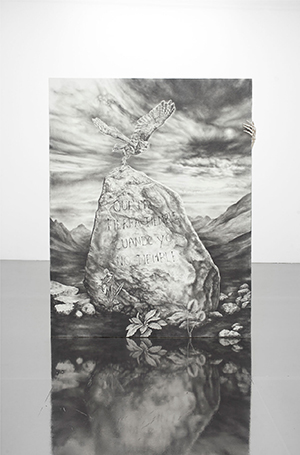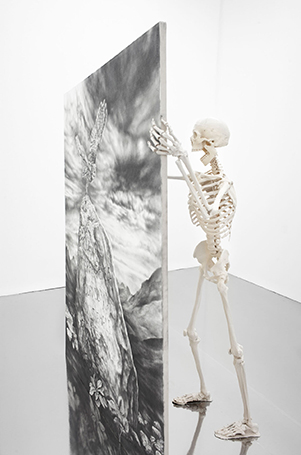

Installation with graphite pencil drawing on coated paper, human skeleton made of welded and enamelled polyester resin, 10 minute sound piece and mirrored platform. Variable measurements. 2022.
Artist Santiago Gasquet
Sound piece Roberta Ainstein
Tragedy was the name of a nineties disco that generated community and mystique from the Lugano neighborhood in Buenos Aires. Santiago saved his flyers, a set of photocopies with black and white apocalyptic images promoting parties. He did not dance there, in that nocturnal basement, because he was not yet of legal age to enter. He was not physically present in those modern versions of the Dionysian festivals, but that air accompanies him and guides him.
Tragedy is presented in a double room in the Piedras Gallery. Installation and sound-light-visual passage that connects layers and worlds. Combining experiences of what happens at a disco party with factors and components that come from the conceptual structure of the tragedy of Ancient Greece, Santiago Gasquet produces a work that, crossing contrasts, fills us with chiaroscuros. He manages to create a minimalist scenario, making him also a multifaceted actor, hero and chorus. Because Gasquet, as does the Attic tragedy and any self-respecting festival, appeals to the spectators/participants to be moved towards the emotional direction that the work traces. This post-pandemic exhibition focuses on the point of atavistic connection that those of us who are still on the side of the living cannot stop occupying. It’s just that we want to continue talking with our dead. And we also want them to do that with us when we are on that side, in the underground world.
Santiago sees the crack as the possibility of connection to the underworld, he crosses it throughout.
Its darkness, acting like the sirens of the Odyssey, pulls us with its sound atmosphere towards a space in which catharsis and conversation with the affections inhabit.
Horror and compassion in tragedy, in a party, in this exhibition.
Like the Fates, with their power to spin and cut the threads of life and make it death, Gasquet here lays out the lines of a sample endowed with that double and indissoluble condition. Both, life and death, obtain enough space and contact to move, because the work vibrates in a tone that penetrates our body through time.
There is here, as in classical tragedy, a genetic double helix. The Apollonian nature of Gasquet’s hyper-controlled, hyper-realistic drawings show us the face of beauty that gives us security. He knows, manages and seduces the appearance that limits and reassures us.
The Dionysian element of his work surpasses the drawings because it is what underlies his entire work, installations and performances included. The meaninglessness of existence, the horror, the suffering, the dissolution of the edges and contours that the God of Wine fosters are here. Santiago makes all this visible and audible. It is the painful background that the artist makes hyperclear.
By separating and subtly linking, like unconscious pieces, certain terms of the procedure of Attic tragedy and dance music, Gasquet knows that the present is always opaque, and life is inexorably failing. This is evidenced by the sample’s chorus. This character that the artist introduces is the collective narrator that gives voice and sound to the wounds of an era. The Tragedy chorus interweaves sounds and phrases of musical themes from that 90s disco that sounds like a subliminal chime that leaves no doubt about its tone: “Please don’t go…”, “What is love”, “The crazy silence….”
Tragedy stresses us and twists us. Leaning on the ear, one of the several faults of our bodies, whispers to us and shapes us. It messes with the tragic musical background of our human condition to locate ourselves in the finite and three-dimensional present. It distorts us in sound. But he doesn’t say goodbye there.
Find another area of our body and do hypnosis from that side. With his hyperrealistic fingers he touches our eyes, and mirrors us. It leads us to a carved phrase that sounds like destiny: “May the earth tremble when I do not tremble.” Then, deaf and blind by its virtuous excess, we are each left facing a point in the tragic scene. We may be standing in the image, in the sound, or in the whole. Still we inspire.
We can do that. Then, like a choir, we viewers reconnect. We exhale to collectively restrain ourselves from that hot breeze we let escape… to return, hopefully, happy as the body at a party.
María Guerrieri
Piedrasgaleria.com
* In the addition to the prologue that Nietzsche wrote for the second edition of The Birth of Tragedy he says the following idea in other words: he maintains agreement with the content of his essay, but for it to be in the same conceptual sense it did not have to be a text. It had to be a song.
